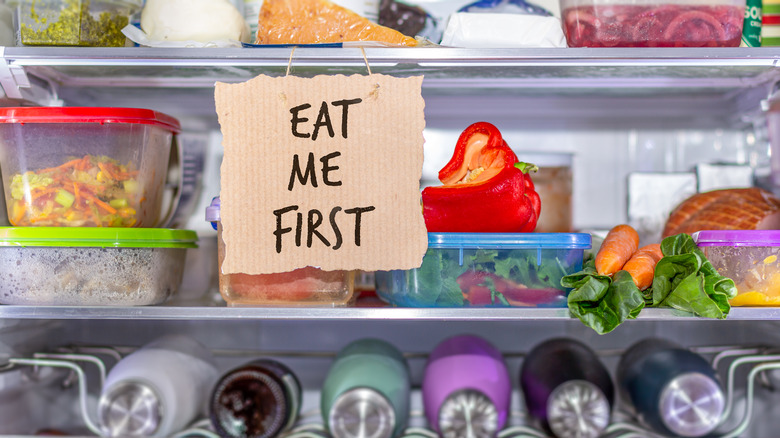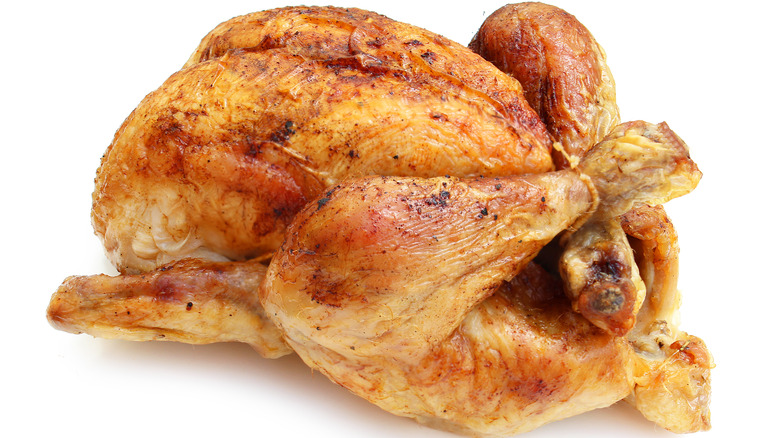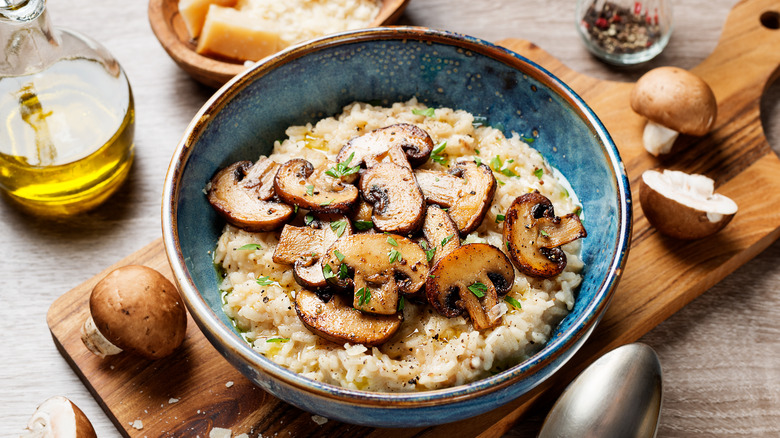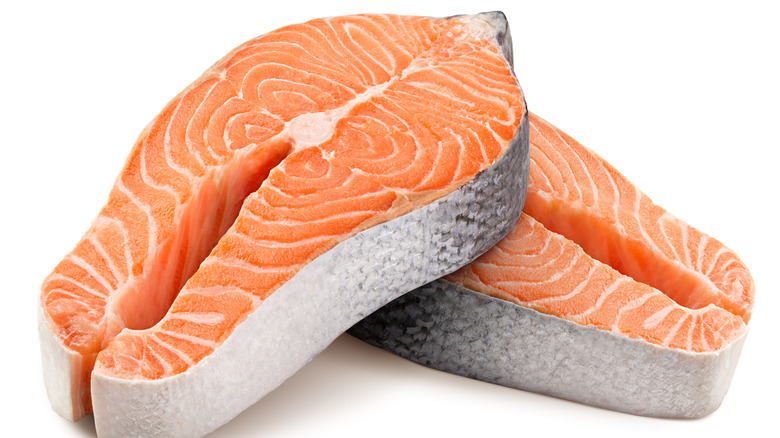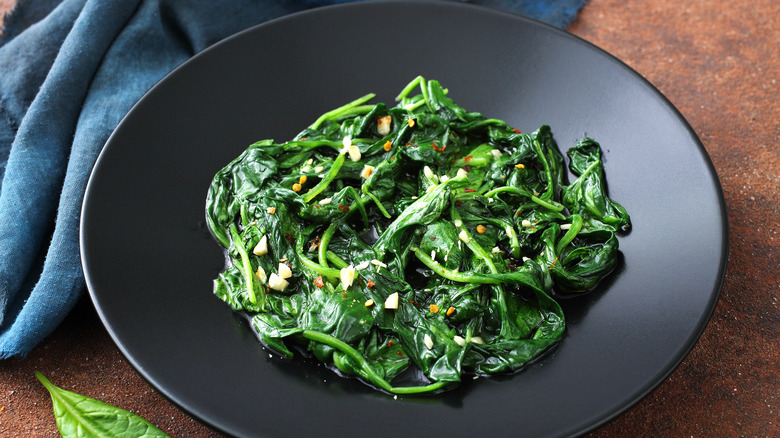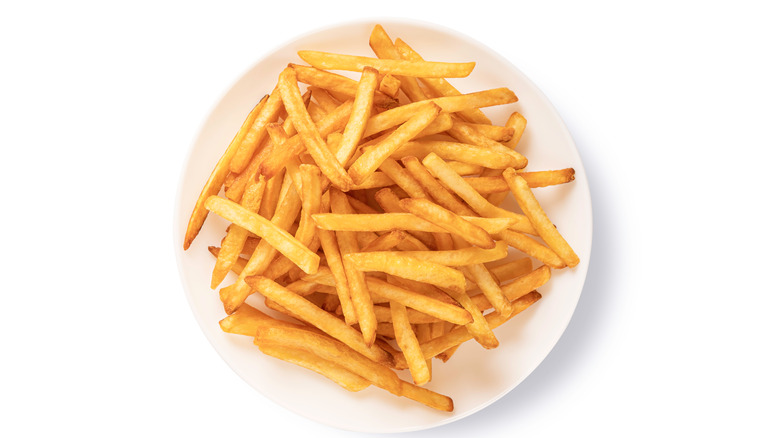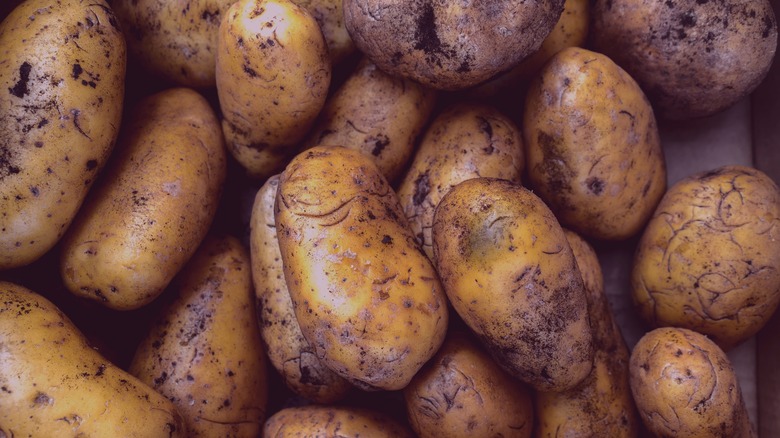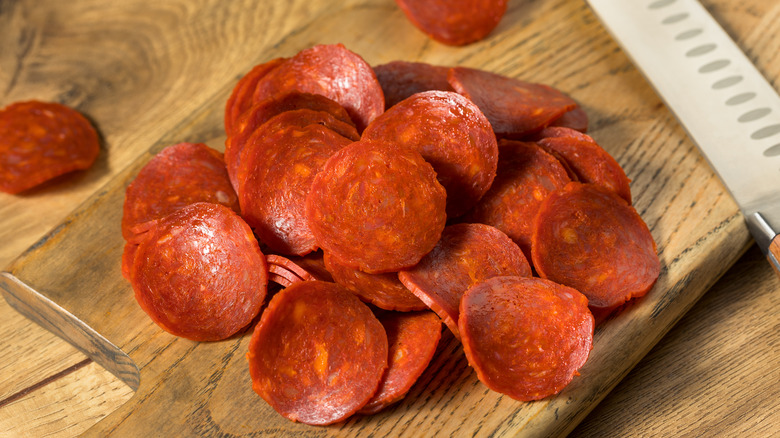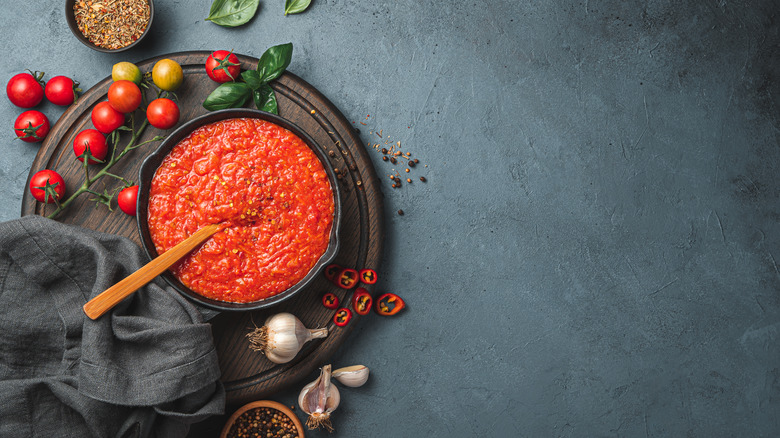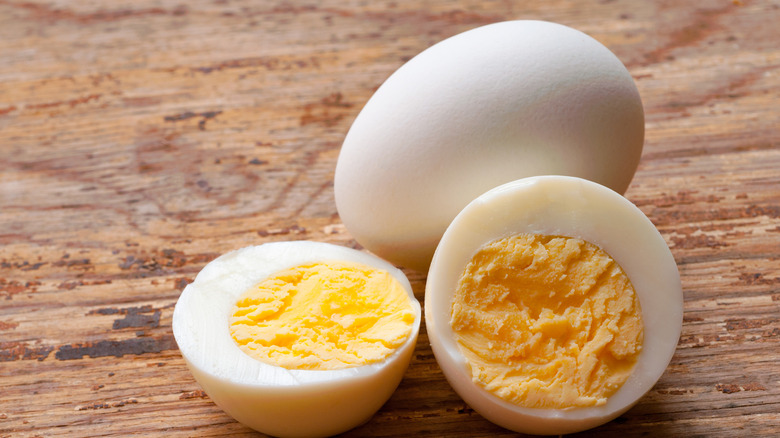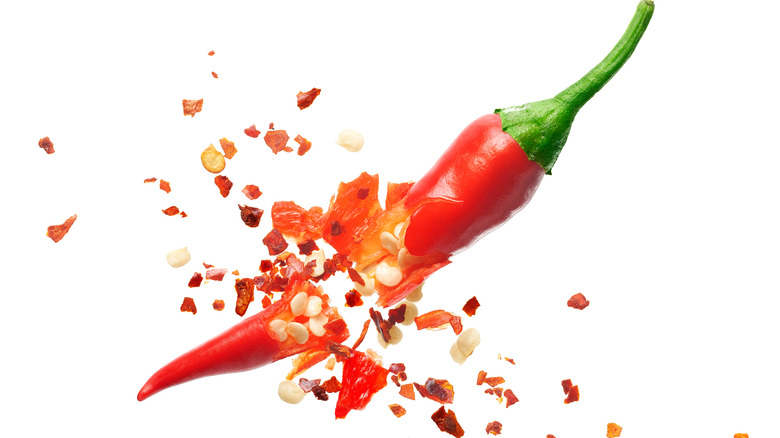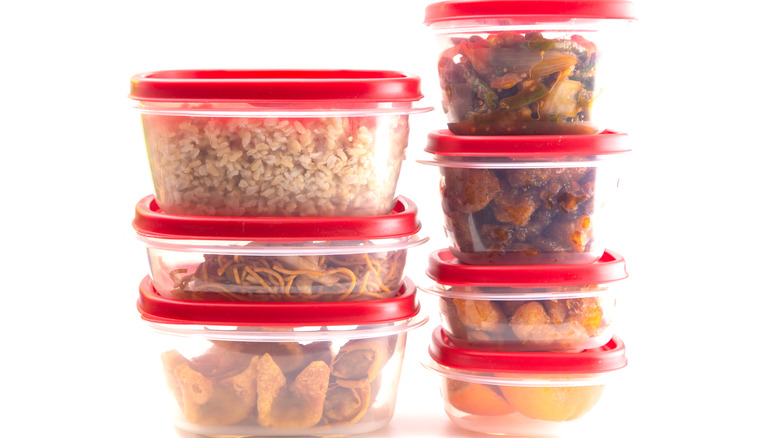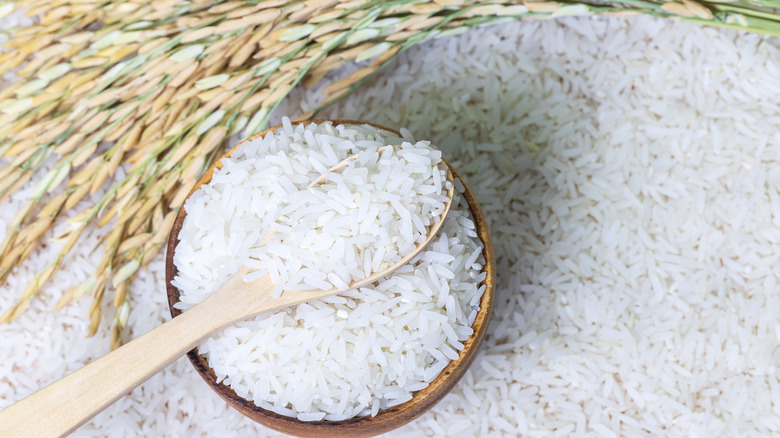15 Leftovers That Can Be Dangerous To Eat
Leftovers make a simple lunch when you're in between meetings or don't have the energy to prep an entirely new meal for yourself. But by the time you get to your leftovers, it's important to note that hazardous pathogens may have gotten to your day-old pizza first. Reheating and eating some leftover foods can lead to foodborne illness and endanger your health and well-being (via the CDC). Other foods are simply dangerous to reheat because they tend to explode in the microwave (via Kitchen Appliance Answer).
When it comes to leftovers and basic food safety, it's first important to note the expiration date on the package. Foods with perishable ingredients, such as eggs or dairy, can quickly spoil even after cooking (via USDA). When examining food, think with your nose and eyes; the USDA notes that spoiled food will typically have an off-color or strange smell. It is equally as important to do your research; there are also some foods you should never refrigerate —including potatoes, according to the FDA — because the cool conditions of the fridge can promote spoilage and staleness. To avoid these possible hazards, here are some leftovers that can be dangerous to eat.
Chicken
Even after cooking, chicken tends to spoil faster than other meats. According to the USDA, cooked chicken should be left in the refrigerator for no longer than four days. Although the fridge slows the growth of pathogens and bacteria, it does not completely stop the spread of E. coli, salmonella, and other foodborne illnesses. Listeria is one bacteria that thrives at cold temperatures in cooked chicken. According to the CDC, listeria causes flu-like symptoms and can be potentially lethal for high-risk populations, including adults over 65, people who are pregnant, and immunocompromised individuals.
There are very obvious signs that your meat is spoiled, including smell, texture, and taste. Rotten cooked chicken will taste exactly as it smells: sour and tangy. The color of the chicken is also important to note; spoiled chicken has more of a gray hue than safe, white chicken that has been cooked (via Livestrong). If you question your chicken's safety, we recommend throwing it out just to be safe.
Mushrooms
Mushrooms are common ingredients in pasta and soups and can be especially tasty if eaten the next day. But can eating leftover mushrooms actually make you sick?
As a rule of thumb, cooked mushrooms should not be left out for more than two hours after cooking to prevent contact with foodborne illnesses, per Chew the World. Dried, frozen, or canned mushrooms are not as dangerous as eating raw mushrooms, according to Lauren Groverman. This is because drying removes the moisture bacteria need to thrive, while freezing makes an inhospitable environment for the bacteria to grow.
If you're looking for the maximum storage life on your sautéed mushrooms, we recommend preparing, freezing, and thawing air-tight portions as needed. Cooked mushrooms need to be consumed within a day and should be reheated to a temperature of at least 165 F to kill off any potential lingering pathogens (via Valuable Kitchen). If you run past the 24-hour deadline, prioritize your safety and toss the mushrooms.
Old salad greens
When you think about foodborne illness, salad greens are likely one of the first foods to come to mind. Per the Canadian Broadcast Coalition, listeria and E. coli are common pathogens for salad greens because of the growing environment — near the ground with exposure to potentially contaminated manure. Despite this information, salad is generally regarded as safe unless recalled by a government organization.
The risk of contamination from these pathogens does not increase foodborne illness. However, eating old, slimy, or foul-smelling lettuce can lead to adverse health effects (via Livestrong). If your lettuce has gone bad and you decide to eat it, you may be putting yourself at risk for gastrointestinal upset. According to Hitchcock Farms, you should eat lettuce within seven to 10 days of purchase and shredded lettuce within three days. If you notice the exterior of your lettuce is spoiled, you can try to salvage the inner leaves that do not appear rotted (via Does it Go Bad).
Seafood
Fresh or raw seafood can be dangerous if left at room temperature for too long, so reheating leftover grilled salmon or tilapia may not always be the best call. Reheating might not kill off any remaining pathogens that can cause foodborne illness (via the FDA). Plus, you are likely unaware of how the fish was actually stored prior to purchase and if it came into contact with pathogens invisible to the human eye.
The FDA also notes that fish and seafood should never be left unrefrigerated for longer than two hours, and the fridge needs to be 40 F or colder. Always wash your hands before and after handling raw fish to prevent the cross-contamination of pathogens to other kitchen surfaces and the human body. Throw fish away if it has been at room temperature for over two hours or at temperatures greater than 90 F for over one hour. If you plan to have leftovers, we recommend storing the fish in the fridge and reheating smaller portions.
Spinach
Raw spinach can be as dangerous as other salad greens like romaine and arugula. But what about cooked spinach?
Cooked spinach is an example of a food that can become toxic when reheated. Spinach is a vegetable rich in naturally-occurring nitrates; these are different than the nitrates found in processed meats and other preserved foods. Foods with these natural nitrates can be beneficial to the body in reducing the risk of developing chronic illnesses and cancers, per WebMD. Other natural sources of nitrates include carrots, lettuce, and bok choi.
Cooking and reheating spinach into a watery mess can concentrate the nitrates (converted to nitrite by stomach acid) in a small portion (via JHSSS). Consuming more than 100 milligrams of nitrites a day can increase the risk of cancer, pregnancy complications, and blue baby syndromes in infants. Populations especially at risk for nitrite consumption include those who are pregnant or thinking about becoming pregnant, older adults, and infants.
Buffet leftovers
Does thinking about buffet food make your stomach queasy? Buffets can be dangerous because of the contact with other patrons (and their sneezes, coughs, and saliva), as well as the risk of leaving food a room temperature for several hours (via CDC). Keep yourself safe by skipping the buffet line altogether, or make sure to use clean tongs and plates and wash your hands before and after taking food from the buffet, per Washington State University Extension.
Food poisoning is always a risk if you reheat food from a buffet. Potatoes, spinach, mushrooms, and rice are particularly dangerous offenders lurking in those silver trays. Although you might think that reheating buffet leftovers in the microwave is enough to kill off any lurking bacteria, a study by Michigan State University showed that it might not get hot enough to do so (via Food Safety News). If you're considering taking home a doggy bag for later, we recommend leaving your leftovers on your plate.
French fries
Oily french fries don't taste the same the next day. But did you know that you should avoid reheating restaurant fries for more than just the lackluster flavor and texture?
If you overheat your french fries past the original frying oil's smoke point, you can cause the oil to release dangerous fumes. Research has suggested linkages between prolonged exposure to cooking fumes and the development of cancers and DNA mutations (via National Library of Medicine).
If you need to reheat french fries, we recommend using a convection oven on low heat or sticking to your favorite kitchen appliance: the air fryer. You should max out your convection oven at 400 F; this temperature is below the smoke point of most types of oil, according to Masterclass. Your air fryer is another go-to, but you may have to cook in small batches if you plan to reheat a lot of fries. Although using an air-fryer may take more time, the machine requires a slightly lower temperature (350 F) and no additional oil.
Potatoes
Reheated potatoes can impact your health, but not for the same reason that french fries may make you sick. Cooked potatoes that have sat for too long may be a carrier for the Clostridium botulinum bacteria — better known as botulism (via BC Centre for Disease Control). Botulism spreads especially well in aluminum foil or plastic wrap, which doesn't bode well for the gratin or scalloped potatoes you took home from the family get-together last night.
According to the CDC, botulism is a particularly dangerous foodborne illness but is considered relatively rare in the United States. Botulism thrives on potatoes because the bacteria prefer low-oxygen, low-acid, and low-sugar surfaces. Reheating potatoes does not necessarily kill off the bacteria, but roasting or cooking the potatoes thoroughly before refrigerating them can reduce the risk of other foodborne illnesses. Cleaning the potatoes well with a vegetable brush and removing the eyes before preparing them is also important because the bacteria do not have anywhere else to hide, per Food Safety News.
Processed meats
Processed meats like bacon, hot dogs, pepperoni, and salami are sources of cholesterol oxidation products (COPs). When you microwave processed meats, the cholesterol in the meat oxidizes and degrades. According to an article published in the National Library of Medicine, these COPs can lead to chronic health conditions, including atherosclerosis (the hardening of the arteries, which transport blood all over your body).
All animal products emit some amount of cholesterol — and many of these products need to be heated to make the food safe for human consumption. The microwave is particularly dangerous because it amplifies COP production. The aforementioned article also revealed pork products like bacon were particularly high in COPs after they were cooked, refrigerated, and reheated in the microwave. Grilling, followed by reheating in the microwave, is also a serious COP offender.
You can reduce your exposure to COPs by reheating processed meats on the grill rather than in the microwave. We recommend starting your bacon in simmering water until the water evaporates before frying the bacon until crisp. This method retains moisture and creates a soft, chewy, and delectable bacon.
Red pasta sauce
If you have ever frozen a batch of pasta sauce, you know the secret is just popping a container in the microwave when you need some sauce for pasta or meatball sandwiches. But microwaving your red sauce can actually cause a dangerous risk for home cooks that isn't biological.
The volatility of red sauce is due to its viscous consistency, according to AZ Central. When the sauce heats up in the microwave, its heavy components — the crushed tomatoes, spices, onion, and garlic — heat up slower than the surrounding water. The water molecules start moving around, producing steam, and searching for a way to release from the container. This movement can cause the sauce to splatter and burn.
One way to prevent explosions in your microwave is to opt for the stovetop instead. The constant stirring motion of the sauce on the stove allows steam to escape and prevents the build-up of pressure. Not only will you avoid a kitchen mess, but your sauce will also be evenly heated and ready for a quick meal.
Grapes
You probably don't think about microwaving grapes often. While we can't think of a purpose to intentionally heat grapes, there's also a really good reason to avoid it. Heating grapes in your microwave creates dangerous sparks and plasma (the same type of matter responsible for the sun's waves and fluorescent lighting) in a matter of seconds. According to Science, research has told us this happens because the water in the grapes traps wavelengths emitted by the microwave. The skin of the grape moves the wavelengths like a conductive wire, supercharging the air with bright rays of plasma.
Even if you are inspired to test this scientific experiment and put grapes in your microwave, we can assure you that it's not worth the risk of ruining a perfectly good kitchen appliance. And, just to be safe, make sure to check for any grapes before heating up a large plate of food in the microwave.
Whole hard-boiled eggs
Reheating shell-on, hard-boiled eggs will cause a dangerous explosion in your microwave. Although science hasn't definitively given humanity a reason for why whole hard-boiled eggs explode in the microwave, the assumption is that it's due to the build-up of pressure in the yolk of the egg. The yolks contain pockets of water that become unstable with heat application. When the water heats, it expands, breaking through the whites and the shell of your egg (via JASA). Not only can the rogue eggshell damage your microwave, but the heat from the egg may also cause scalding burns.
If you need to reheat hard-boiled eggs at home, we recommend placing the eggs in a tempered (heat-safe) container and pouring hot water over the eggs. Let the eggs bathe in the warm water for 10 to 20 minutes until the eggs are warm. Crack your eggs open and enjoy a scald-free eating experience.
Spicy peppers
Spicy peppers may be some folks' idea of a fun time. But when we endorse hot peppers, we don't endorse reheating hot peppers in your microwave. Hot peppers contain capsaicin, a chemical that makes the flavor too spicy for predators to eat. When hot peppers are placed in a microwave, the capsaicin is aerosolized and mimics the sensation of pepper spray in the human body (via WHAM).
Used for self-defense, pepper spray has numerous impacts on human health, most commonly inflammation and irritation in the nasal cavity and throat (via NCCEH). Exposure to aerosolized capsaicin causes symptoms within thirty minutes, and the compound can easily pass through windows and doors. People with asthma and respiratory illnesses can be significantly impacted by irritation via aerosolized capsaicin (via Scientific American).
The National Capital Poison Center recommends using gloves to protect the skin and mucous membranes when handling hot peppers. Avoid touching your eyes, and wash your hands after you finish to avoid contaminating other surfaces or parts of the body.
Leftovers you've already reheated
If you took out a larger portion of leftovers than you can eat, you can probably relate to the internal dilemma of whether or not you should place the remainder back in your fridge. The answer, from a food safety perspective, is a definite no. If you reheat leftovers more than once, you can increase your exposure to spoiled food and pathogens. Repeatedly changing temperatures in food creates a hospitable environment for bacteria, mold, and fungus (via BBC Good Food).
To prevent contamination, the USDA recommends heating the food to 165 F (check it with a thermometer to be as exact as possible) for at least two minutes. You should also ensure your leftovers are equally heated throughout; it will result in a better (and safer) leftover experience. If you plan to eat some leftovers (but not all), take part of the food out of the container and heat it up on a separate plate. This will reduce the amount of time the food is at room temperature collecting bacteria.
Rice
Everyone knows the key to perfect fried rice is using day-old rice. But beware, leftover rice may not be entirely safe because it might be the ideal habitat for Bacillus cereus spores. Most (but not all) of these bacteria are killed off at high temperatures. However, if the rice is left at room temperature for too long, the spores can spread and cause food poisoning. Rice that is ready for the trash will come with a pungent, acidic odor (via I Forgot It's Wednesday).
To keep your rice safe, you'll want to refrigerate the grains within two hours of cooking, according to Masterclass. Try to store rice in shallow containers to allow the heat to disperse faster. To reheat (which should only be done once), place the rice in a microwave-safe container with a few tablespoons of water and heat until it is steaming hot in the middle, per the National Institute of Health.
